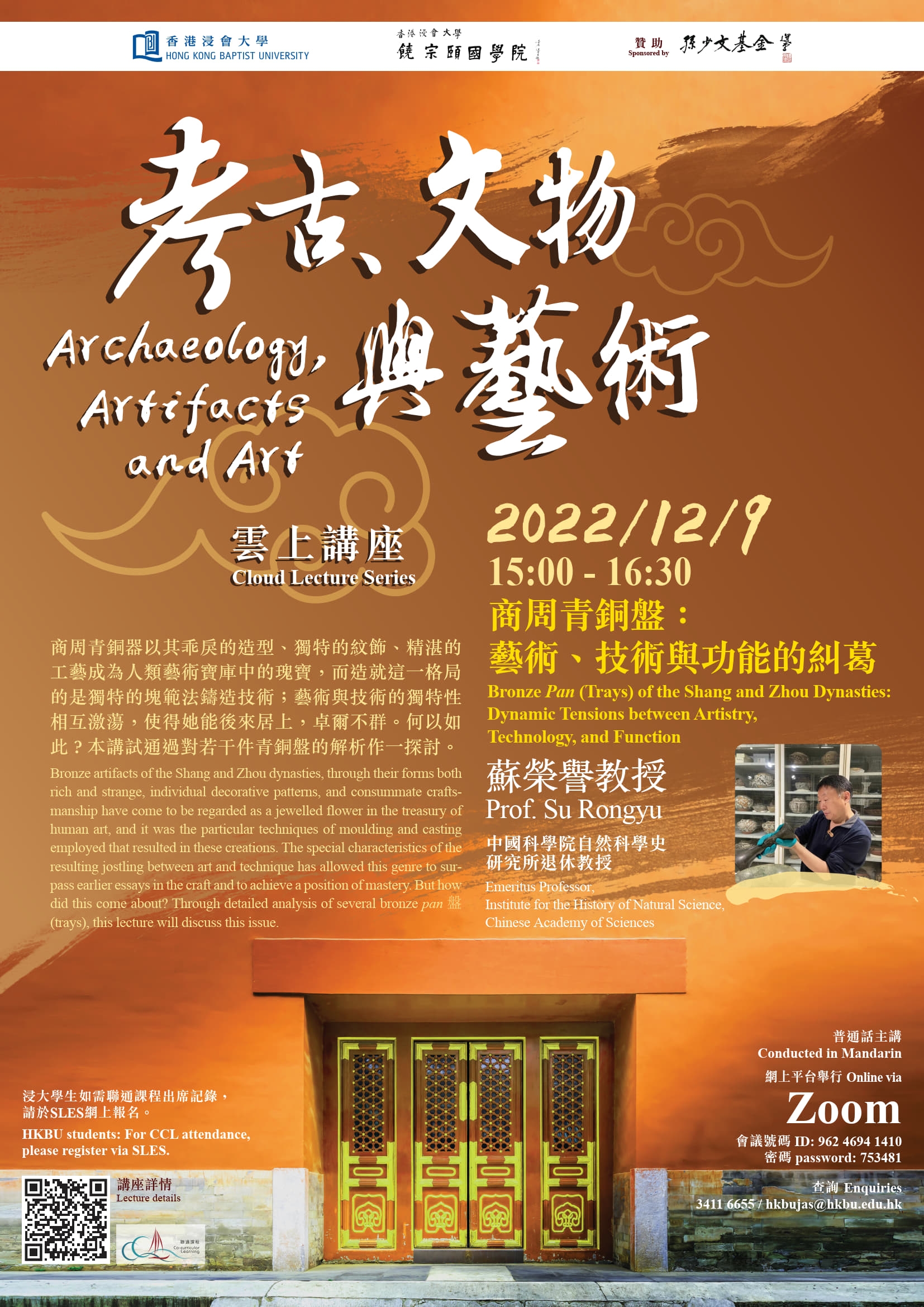Bronze Pan (Trays) of the Shang and Zhou Dynasties: Dynamic Tensions between Artistry, Technology, and Function(2022/12/9)

Sponsored by Simon Suen Foundation, the “Archaeology, Artifacts and Art” Cloud Lecture Series will be held from November 2022 to August 2023. The Academy will curate a series of lectures on archaeology, history, artifacts and art in collaboration with experts and scholars locally and abroad, including esteemed researchers art collectors as well as connoisseurs. With the splendor of the pantheon, we endeavor to embark on a journey of discovery with international academics and students from different backgrounds.
No registration is required for this lecture series. All are welcome to attend each lecture with the following Zoom meeting details:
https://hkbu.zoom.us/j/96246941410?pwd=ZHg0ZnFBbGMxczFXNzBFYnVHZS8zZz09
Zoom Meeting ID: 962 4694 1410
Password:753481
HKBU students: For CCL attendance, please (1)register via SLES before the activity, (2) log in Zoom using HKBU email account, with your name as "STUDENT ID NO. + NAME", and (3) complete and submit the Co‐curricular Learning Evaluation Forms after the activity in 3 working days.
Note: A CCL-recognised event must be at least 1.5 hours long. Please observe the requirements if students wish to update the attendance record.
Third Lecture: Bronze Pan (Trays) of the Shang and Zhou Dynasties: Dynamic Tensions between Artistry, Technology, and Function
Date: 9 December 2022, Friday
Time: 15:00–16:30 (Hong Kong time)
Speaker: Prof. Su Rongyu (Emeritus Professor, Institute for the History of Natural Science, Chinese Academy of Sciences)
Language: Mandarin
Abstract: Bronze artifacts of the Shang and Zhou dynasties, through their forms both rich and strange, individual decorative patterns, and consummate craftsmanship have come to be regarded as a jewelled flower in the treasury of human art, and it was the particular techniques of moulding and casting employed that resulted in these creations. The special characteristics of the resulting jostling between art and technique has allowed this genre to surpass earlier essays in the craft and to achieve a position of mastery. But how did this come about? Through detailed analysis of several bronze pan 盤 (trays), this lecture will discuss this issue.
Speaker Bio:
Su Rongyu was born in 1962 in Shanyang in the province of Shaanxi. In 1979, he entered the School of Mechanical Engineering of Xi’an Jiaotong University, specialising in studying casting techniques and equipment, and graduated in 1983 with a Bachelor’s degree in Engineering. The same year, he gained admission to the University of Science and Technology of China as a research student specialising in the history of the natural sciences, and under the supervision of Professor Hua Jueming, studied the history of metallurgy, graduating in 1986 with a Master’s degree in Science.
In 1986, he entered the Institute for the History of Natural Science of the Chinese Academy of Sciences and worked in succession as an intern research officer, assistant research officer, and in 1996 was promoted to the rank of research associate. In 1997–1998, he worked at the Institute for Philosophy of Technical University of Berlin (TU-Berlin) as a senior visiting scholar and carried out research into the history of technology. 2000–2001 saw him in the role of a Forbes Fellow of the Smithsonian Institution in Washington, and at the Freer Gallery of Art and Arthur M. Sackler Gallery of Art, he initiated research into the artistry and technologies of bronze artifacts. In 2001, he was promoted to the rank of Research Fellow and a supervisor of doctoral students, and took on the joint roles of Executive Director and General Secretary of the Chinese Society for the History of Science and Technology, and concurrently served as the academic committee member of the Peking University Ancient Chinese Archaeology Research Centre. In 2004, he founded the Centre for Traditional Artistry and the Scientific Study of Cultural Relics of the Chinese Academy of Sciences and was appointed as its first Director. During 2003–2012, he was a visiting professor and carried out scholarly and pedagogic activities at the University of Tübingen (Uni-Tübingen), TU-Berlin, and the Goethe University Frankfurt (Uni-Frankfurt am Main). In 2017, he initiated joint research as a visiting professor at the British Museum, and in August 2022, retired from formal scholarly employment.
The focus of his lifetime’s work has been research into ancient metallurgic technologies and art, and this has touched on various disciplines including the history of technology, art history (the archeology of art), archeology, scientific and technological archeology, and the preservation of historic artifacts. He has published more than a hundred scholarly monographs and papers.
Summary(Recorded by Zhang Jinfa):
本講座以商周青銅盤為對象,將其放在商周青銅盤演變的大背景下進行認識,並分析其關鍵風格和技術要素的淵源關係。
講者指出當今盤是普通的日用器具,但早期中國並非如此。早在新石器時代晚期,陶寺文化的彩繪陶盤,專為隨葬大墓而作,裝飾一致。
迄今所知的青銅盤最早可上溯到商早期,呈現出與這時其他類型青銅器工藝和風格一致、而與其他文明大不相同的特質。青銅盤從中商階段開始,內壁出現紋飾成為盤的特點,與其他類型容器有別。晚商早期盤內壁紋飾頗繁複,如偶有鳥飾,但為時短暫,晚商中期即出現簡化傾向,內壁紋飾迅速消逝,銘文孤立其中。
西周開始,銘文漸長,在西周中期則多至百字,盤似乎成為銘文載體。 兩周之際鑄工的求變態度,一方面復古晚商盤內紋飾,另一方面增添附飾,展現高度的工藝技巧,著眼於炫技以製作玩物和葬器,成為理解商周青銅器的一個重要側面。
最後,講者歸納春秋晚期和戰國早期的青銅盤差異,反映了地區鑄銅的不同風格,並總結商周青銅器以其乖戾的造型、獨特的紋飾、精湛的工藝成為人類藝術寶庫中的瑰寶。
